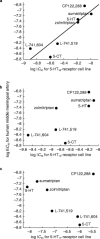Vasoconstriction in human isolated middle meningeal arteries: determining the contribution of 5-HT1B- and 5-HT1F-receptor activation
- PMID: 10073743
- PMCID: PMC2014192
- DOI: 10.1046/j.1365-2125.1999.00851.x
Vasoconstriction in human isolated middle meningeal arteries: determining the contribution of 5-HT1B- and 5-HT1F-receptor activation
Abstract
Aims: Sumatriptan is a 5-HT1B/1D-receptor agonist which also has affinity for 5-HT1F-receptors. The vasoconstrictor effects of sumatriptan are thought to be 5-HT1B-receptor mediated and these receptors have been shown to be expressed in human cranial blood vessels. However, in the same tissue mRNA coding for 5-HT1F-receptors has also been identified and this study addresses the possibility of whether 5-HT1F-receptor activation contributes to vasoconstriction.
Methods: The ability of two selective 5-HT1B/1D-receptor antagonists (GR125,743 and GR127,935) with no affinity for 5-HT1F-receptors, to inhibit sumatriptan evoked contractions in human isolated middle meningeal artery was investigated. Using a series of 5-HT1B/1D-receptor agonists (sumatriptan, zolmitriptan, CP122,288, L-741,519 and L-741,604), some with high affinity for 5-HTIF-receptors and the non-selective 5-HT-receptor agonists 5-HT and 5-CT, we compared the vasoconstrictor potency of these drugs in human isolated middle meningeal artery with their affinities at cloned human 5-HT1B-, 5-HT1D-and 5-HT1F-receptors expressed in CHO cell lines.
Results: GR125,743 antagonized sumatriptan evoked contractions in a competitive manner (apparent pA2 9.1) and GR127,935 antagonized sumatriptan-induced responses in a non-competitive manner (reducing the maximum contraction to 27%). There was a significant correlation between vasoconstrictor potency and 5-HT1B-receptor affinity (r=0.93, P=0.002) but not with 5-HT1D- or 5-HT1F-receptor affinity (r=0.74, P=0.06; r= 0.31, P= 0.49, respectively).
Conclusions: These experiments show that in human middle meningeal artery vasoconstriction to sumatriptan-like agents is 5-HT1B-receptor mediated with little if any contribution from 5-HT1F-receptor activation.
Figures


Similar articles
-
5-HT1B-receptors and vascular reactivity in human isolated blood vessels: assessment of the potential craniovascular selectivity of sumatriptan.Br J Clin Pharmacol. 2002 Mar;53(3):266-74. doi: 10.1046/j.0306-5251.2001.01536.x. Br J Clin Pharmacol. 2002. PMID: 11874390 Free PMC article.
-
Characterization of binding, functional activity, and contractile responses of the selective 5-HT1F receptor agonist lasmiditan.Br J Pharmacol. 2019 Dec;176(24):4681-4695. doi: 10.1111/bph.14832. Epub 2019 Nov 7. Br J Pharmacol. 2019. PMID: 31418454 Free PMC article.
-
Involvement of 5-HT(1B/1D) and 5-HT2A receptors in 5-HT-induced contraction of endothelium-denuded rabbit epicardial coronary arteries.Br J Pharmacol. 1997 Nov;122(5):875-84. doi: 10.1038/sj.bjp.0701470. Br J Pharmacol. 1997. PMID: 9384503 Free PMC article.
-
5-HT receptors mediating external carotid vasoconstriction in vagosympathectomized dogs.Zhongguo Yao Li Xue Bao. 1999 Dec;20(12):1057-67. Zhongguo Yao Li Xue Bao. 1999. PMID: 11216445 Review.
-
Migraine: pathophysiology, pharmacology, treatment and future trends.Curr Vasc Pharmacol. 2003 Mar;1(1):71-84. doi: 10.2174/1570161033386826. Curr Vasc Pharmacol. 2003. PMID: 15320857 Review.
Cited by
-
Lasmiditan and 5-Hydroxytryptamine in the rat trigeminal system; expression, release and interactions with 5-HT1 receptors.J Headache Pain. 2022 Feb 17;23(1):26. doi: 10.1186/s10194-022-01394-z. J Headache Pain. 2022. PMID: 35177004 Free PMC article.
-
Functional Characterization of 5-HT1B Receptor Drugs in Nonhuman Primates Using Simultaneous PET-MR.J Neurosci. 2017 Nov 1;37(44):10671-10678. doi: 10.1523/JNEUROSCI.1971-17.2017. Epub 2017 Oct 2. J Neurosci. 2017. PMID: 28972127 Free PMC article.
-
5-HT1B-receptors and vascular reactivity in human isolated blood vessels: assessment of the potential craniovascular selectivity of sumatriptan.Br J Clin Pharmacol. 2002 Mar;53(3):266-74. doi: 10.1046/j.0306-5251.2001.01536.x. Br J Clin Pharmacol. 2002. PMID: 11874390 Free PMC article.
-
Cardiovascular responses produced by 5-hydroxytriptamine:a pharmacological update on the receptors/mechanisms involved and therapeutic implications.Naunyn Schmiedebergs Arch Pharmacol. 2007 Oct;376(1-2):45-63. doi: 10.1007/s00210-007-0179-1. Epub 2007 Aug 17. Naunyn Schmiedebergs Arch Pharmacol. 2007. PMID: 17703282 Review.
-
Using antidepressants and the risk of stroke recurrence: report from a national representative cohort study.BMC Neurol. 2015 Jun 5;15:86. doi: 10.1186/s12883-015-0345-x. BMC Neurol. 2015. PMID: 26045186 Free PMC article.
References
-
- Connor HE, Beattie DT. 5-Hydroxytryptamine receptor subtypes and migraine. In: Sandler M, Ferrari M, Harnett S, editors. Migraine: Pharmacology and Genetics. Chapman and Hall; 1996. pp. 18–31.
-
- Friberg L, Olesen J, Iversen HK, Sperling B. Migraine pain associated with middle cerebral artery dilatation: reversal by sumatriptan. Lancet. 1991;338:13–17. - PubMed
-
- Humphrey PPA, Feniuk W. Mode of action of the anti-migraine drug sumatriptan. Trends Pharmacol Sci. 1991;12:444–446. - PubMed
-
- Moskowitz MA. Neurogenic versus vascular mechanisms of sumatriptan and ergot alkaloids in migraine. Trends Pharmacol Sci. 1992;13:307–311. - PubMed
MeSH terms
Substances
Grants and funding
LinkOut - more resources
Full Text Sources

